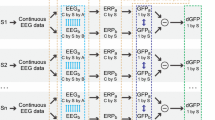Summary
Electroencephalographic data recorded for topographical analysis constitute multidimensional observations, and the present paper illustrates methods of data analysis of multichannel recordings where components of evoked brain activity are identified quantitatively. The computation of potential field strength (Global Field Power, GFP) is used for component latency determination. Multivariate statistical methods like Principal Component Analysis (PCA) may be applied to the topographical distribution of potential values. The analysis of statistically defined components of visually elicited brain activity is illustrated with data sets stemming from different experiments. With spatial PCA the dimensionality of multichannel data is reduced to only three components that account for more than 90% of the variance. The results of spatial PCA relate to experimental conditions in a meaningful way, and this method may also be used for time segmentation of topographic potential maps series.
Similar content being viewed by others
References
Chapman, R.M., McCrary, J.W., Bragdon, H.R. and Chapman, J.A. Latent components of event-related potentials functionally related to information processing. In: J.E.Desmedt (Ed.), Progress in Clinical Neurophysiology, Karger, Basel, 1979, Vol.6: 80–105.
Donchin, E. A multivariate approach to the analysis of average evoked potentials. IEEE Trans. Bio-med. Engng., 1966: 13, 131–139.
Donchin, E. and Heffley, E.F. Multivariate analysis of event-related potential data: a tutorial review. In: D. Otto (Ed.), Multidisciplinary Perspectives in Event-Related Brain Potential Research Washington, U.S. Environmental Protection Agency, 1978: 555–572.
Glaser, E.M. and Ruchkin, D.S. Principles of Neurbiological Signal Analysis. New York: Academic Press, 1976.
Gorsuch, R.L. Factor Analysis. Hillsdale, NJ: Lawrence Erlbaum Ass, 1983.
Harman, H.H. Modern Factor Analysis (2nd ed.). Chicago: The University of Chicago Press, 1967.
Harner, R. and Riggio, S. Application of Singular Value Decomposition to Topographic Analysis of Flash-Evoked Potentials. Brain Topography, this issue.
Hjorth, B. Eigenvectors and eigenfunctions in spatio-temporal EEG analysis. Brain Topography, this issue.
John, E.R., Ruchkin, D.S. and Vidal, J.J. Measurement of eventrelated potentials. In: E. Callaway, R. Tueting, and S.H. Koslow (Eds), New York, Academic Press, 1978: 93–138.
Lehmann, D. and Skrandies, W. Multichannel mapping of spatial distributions of scalp potential fields evoked by checkerboard reversal to different retinal areas. In: D. Lehmann and E.Callaway (Eds.), Human Evoked Potentials: Applications and Problems. Plenum Press, New York, 1979: 201–214.
Lehmann, D. and Skrandies, W. Reference-free identification of components of checkerboard-evoked multichannel potential fields. Electroenceph. Clin. Neurophysiol., 1980, 48: 609–621.
Lehmann, D. and Skrandies, W. Time segmentation of evoked potentials (EPs) based on spatial scalp field configuration in multichannel recordings. Electroenceph. clin. Neurophysiol., 1986, Suppl. 38: 27–29.
Möcks, J. and Verleger, R. Principal component analysis of event-related potentials: a note on misallocation of variance. Electroenceph. Clin. Neurophysiol., 1986, 65: 393–398.
Rösler, F. and Manzey, D. Principal components and varimaxrotated components in event-related potential research: some remarks on their interpretation. Biol. Psychol., 1981 13: 3–26.
Skrandies, W. Latent components of potentials evoked by visual stimuli in different retinal locations. Int. J. Neurosci., 1981, 14: 77–84.
Skrandies, W. Visual evoked potential topography: methods and results. In: F.H. Duffy (Ed.), Topographic Mapping of Brain Electrical Activity, Butterworths, Boston, 1986: 7–28.
Skrandies, W. The upper and lower visual field of man: electrophysiological and functional differences. Progress in Sensory Physiology, 1987, 8: 1–93.
Skrandies, W. Time range analysis of evoked potential fields. Brain Topography, 1988, 1: 107–116.
Skrandies, W. and Lehmann, D. Spatial principal components of multichannel maps evoked by lateral visual half-field stimuli. Electroenceph. Clin. Neurophysiol., 1982, 54: 662–667.
Skrandies, W., Chapman, R.M., McCrary, J.W. and Chapman, J.A. Distribution of latent components related to information processing. Ann. N.Y. Acad. Sci., 1984, 425: 271–277.
Skrandies, W., Dodt, E., Kofmel, B.A. and Michel, Ch. Scalp potential field topography evoked by lateralized dynamic random-dot stereograms. Invest. Ophthalmol. Vis. Sci., 1989, Suppl. 30: 515.
Wood, C.C. and McCarthy, G. Principal component analysis of event-related potentials: simulation studies demonstrate misallocation of variance across components. Electroenceph. Clin. Neurophysiol., 1984, 59: 249–260.
Author information
Authors and Affiliations
Additional information
Acknowledgements: Part of the experimental work described in this paper has been supported by F. Lawrenz, nbn Medizin-Elektronik/Biologic Systems Corp.
Rights and permissions
About this article
Cite this article
Skrandies, W. Data reduction of multichannel fields: Global field power and Principal Component Analysis. Brain Topogr 2, 73–80 (1989). https://doi.org/10.1007/BF01128845
Accepted:
Issue Date:
DOI: https://doi.org/10.1007/BF01128845




